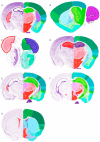Unveiling the Neurotoxic Effects of Ochratoxin A and Its Impact on Neuroinflammation
- PMID: 40559842
- PMCID: PMC12197389
- DOI: 10.3390/toxins17060264
Unveiling the Neurotoxic Effects of Ochratoxin A and Its Impact on Neuroinflammation
Abstract
Ochratoxin A (OTA), a toxic compound generated by Aspergillus and Penicillium fungi, is a common contaminant in different food and animal feed sources, thereby posing possible dangers to human well-being. Although OTA is widely recognized for its kidney-damaging properties, new findings have also indicated its potential to harm the nervous system. Current research trends have increasingly examined the part played by environmental poisons, such as mycotoxins, in the development of diseases. This systematic review gathers and assesses the features of OTA along with the insights acquired from studies on its neurotoxicity. This work presents recent research that demonstrates some mechanisms by which OTA crosses the intestinal and blood-brain barriers, penetrating neural structures. In addition, it discusses the effect of OTA on several types of neural cells and its roles in apoptosis, neuroinflammation, and neurogenesis defects, while also determining the effects of antioxidant systems that neutralize the effects of OTA. This paper identifies crucial gaps in the research and highlights the necessity for further in-depth studies into how OTA affects the processes underlying neurodegeneration. Filling these knowledge gaps could provide valuable insights into the neurotoxic potential of OTA and its relevance to neurological disorders.
Keywords: inflammation; mycotoxins; nervous system; neurodegeneration; ochratoxin A.
Conflict of interest statement
The authors declare no conflicts of interest.
Figures






References
-
- Coffey R., Cummins E., Ward S. Exposure assessment of mycotoxins in dairy milk. Food Control. 2009;20:239–249. doi: 10.1016/j.foodcont.2008.05.011. - DOI
-
- Food and Agriculture Organization of the United Nations; World Health Organization; United Nations Environment Programme, editor. Report of the Joint FAO/WHO/UNEP Conference on Mycotoxins Held in Nairobi, 17–19 September 1977. Food and Agriculture Organization of the United Nations; Rome, Italy: 1977. 107p FAO food and nutrition paper.
Publication types
MeSH terms
Substances
LinkOut - more resources
Full Text Sources

